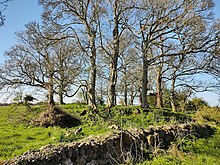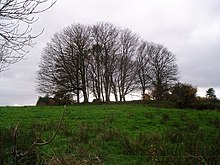
Fairy forts (also known as lios or raths from the Irish, referring to an earthen mound) are the remains of stone circles, ringforts, hillforts, or other circular prehistoric dwellings in Ireland. From possibly the late Iron Age to early Christian times, people built circular structures with earth banks or ditches. These were sometimes topped with wooden palisades and wooden framed buildings. As the dwellings were not durable, only vague circular marks often remained in the landscape. The remains of these structures, in conjunction with the vegetation around them, are associated with local traditions and folklore, perhaps involving fairies or other supposed supernatural entities, who would "defend" the structures from destruction by builders or farmers.
As of 1991, there were between thirty and forty thousand identifiable fairy forts in Ireland's countryside, the oldest of them possibly dating back as early as 600 BCE.
Interpretation

Tradition claimed that ringforts were "fairy forts" imbued with druids' magic, and believers in the fairies did not alter them. The early pre-Celtic inhabitants of Ireland came to be seen as the mythical Tuatha Dé Danann and Fir Bolg. They were associated with stories of fairies – also known as the "Good People". Fairy forts and prehistoric tumuli were seen as entrances to their world. Even cutting brush, especially the sceach or whitethorn, on fairy forts was reputed to be the death of those who performed the act.
There are many folk tales about supernatural events happening at fairy forts. Actual accidents which occurred at ringforts could be given supernatural explanations. For example, a man who tried to blast a dolmen suffered a septic hand. The wrecked dolmen was subsequently left untouched.
Other traditions hold that a leprechaun may allegedly know of hidden gold in a fairy fort.
In literature, British author Rudyard Kipling made allusions to the process by which such legends grow in his 1906 novel, Puck of Pook's Hill.
Folk tales

Folk tales associated with fairy forts typically relate a curse or retribution enacted upon those who would disturb or destroy the structures. For example, one story collected in 1907 tells that a man who had engaged workers to level an earthwork fairy fort at Dooneeva or Doonmeeve (near Lahinch in County Clare) fell dead; his wife, a wise woman, magically resurrected him unharmed.
Other folk tales relate to the taking of farm animals or people (typically women or children) by the reputed occupants of fairy forts.
In 1966, a man named Tim Hayes buried himself for 101 hours in a fairy fort to hear the earth sounds and prove that there were no fairies in fairy forts. He reiterated the exploit several times, once for over 239 hours in a fairy fort in Monamolin, County Wexford in June 1970.
In 2011, the financial ruin of Seán Quinn, formerly the richest person in Ireland, was blamed on his moving a fairy fort. Some also believed the same about the financial downfall of John DeLorean.
In 2007, Danny Healy-Rae suggested that the N22 remained in bad condition despite renovation work because it was built on a local network of fairy forts, while the Road Department talked about "a deeper underlying subsoil/geotechnical problem". The same issue rose up again in 2017.
See also
References
- "Fairy Forts, Music, & Language of Ireland". www.romanceeverafter.com. Archived from the original on 16 June 2007.
- "The Celts & Celtic Ireland". Archived from the original on 7 December 2006.
- ^ Barber, Natalie (2014). "The Way They Never Were: Nationalism, Landscape, and Myth in Irish Identity Construction". Georgia State University: 44.
- ^ "Fairy forts: Why these 'sacred places' deserve our respect". irishtimes.com. Irish Times. 9 August 2017. Retrieved 19 May 2020.
- Ó Giolláin, Diarmuid (1991). "The fairy belief and official religion in Ireland". The Good People: New Fairylore Essays. New York: Garland. pp. 199–214. ISBN 9780824071004.
- "An Other World". The British Council, Poland. 2004. Archived from the original on 25 April 2007.
- Eddie Lenihan and Carolyn Eve Green, Meeting The Other Crowd: The Fairy Stories of Hidden Ireland, p 125 ISBN 1-58542-206-1
- "A Folklore Survey of County Clare: Fairies and Fairy Forts and Mounds". Clarelibrary.ie. Retrieved 13 March 2014.
- "THE LEPRECHAUN". Ethnic Dolls From Around The World - National and Regional Costumes. Retrieved 13 March 2014.
- Rudyard Kipling. "Puck of Pook's Hill". www.gutenberg.org.
- "A Folklore Survey of County Clare: Fairies and Fairy Forts and Mounds". www.clarelibrary.ie.
- "Tales of Fairies and the Ghost World: Fairy Cows". www.sacred-texts.com.
- "Readings". canvas.wisc.edu. Retrieved 23 October 2018.
- "WATCH: Cork locals speak out after man plans fairy fort burial stunt in 1966". IrishCentral.com. 25 May 2022. Retrieved 6 December 2024.
- Greg Harkin (4 December 2012). "Sean Quinn's downfall is fairies' revenge say locals in Cavan". Independent.ie. Retrieved 13 March 2014.
- Lucey, Anne (19 February 2007). "Fairies blamed for hollow in road". The Irish Times. Retrieved 6 December 2024.
- "Are magical forts to blame for road problems in Ireland?". The Guardian. 9 August 2017. ISSN 0261-3077. Retrieved 6 December 2024.
- "Danny Healy-Rae claims fairy forts caused dip in Kerry road". irishtimes.com. Irish Times. 8 August 2017. Retrieved 19 May 2020.